Text
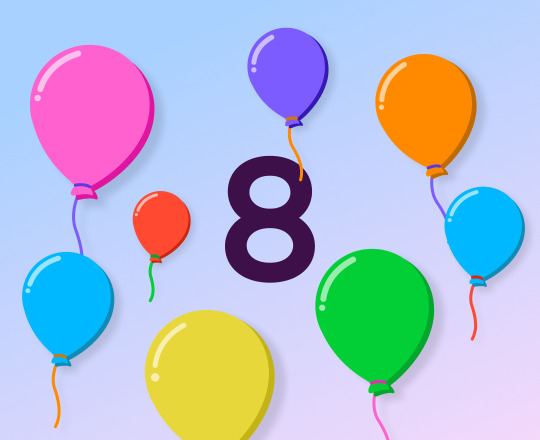
It's my 8 year anniversary on Tumblr 🥳
0 notes
Photo

Grand European Tour, Budapest to Amsterdam—Final Day
August 24, Amsterdam, Netherlands
Today I was without a camera and on my own after breakfast. I said a final good-bye to Jo and Jack and a few other friends who were still on board for breakfast. My taxi was picking me up at 11 a.m. and I headed into Amsterdam to the Hotel Mozart.

Viking offers a post-cruise stay and tour for two days. I did not opt for that because I thought I could get a better deal. In hindsight, I may have saved $100 but I only stayed one day. They stayed two nights and had a tour of the city on the second day. I paid for a canal cruise and a meal. My hotel had a free continental breakfast.
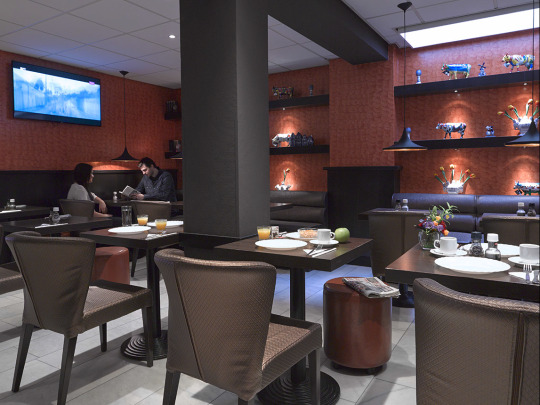
I liked it very much, based on a central location close to the Rijks Museum and down the street from the Anne Frank Museum. It was tiny, though. A single room, with a bathroom almost as large as the bed area. I did like that they put a fan in the room to make it more comfortable. I would go there again, though I don’t think I am inclined to go back to Amsterdam. It was far too hectic a pace with bicyclists to watch out for (Killer bicyclists, the guides in Germany called them), as well as cars. And on the canal, a cluster of boats. I was so hungry, and should have just gotten a slice of pizza, but sat at a restaurant to enjoy a Dutch meal of veal croquettes and a grilled Gouda cheese sandwich. As a result, I missed going to the Rijks museum, which I had hoped to see, especially for the miniature displays. I didn’t expect to get into the Anne Frank museum, because the lines get long, but when I passed it on the canal boat ride, it didn’t look too bad.
One thing to get used to when going from Hungary to other parts of Europe is the currency difference. I actually felt more comfortable spending thousands of forints versus Euros because I knew that the thousands of forints only came to a few dollars and when I spent Euro, I knew it was actually more expensive dollar-wise than the amount I was being charged. So a 103 euro bill was actually $117.
I ended up sleeping a lot in Amsterdam—maybe because I was so tired from all the tours I went on or the high stress of Amsterdam’s manic vibe. I have to say, too, that the taxi driver upset me by charging more than I was told the cost would be. And because I needed a ride to the airport, I did agree to let him pick me up because the price he gave, 45 euro, sounded fair. When he got there and I sat in the car, he gave me a story that the traffic to the airport was so heavy and it might cost more. I said I only have enough based on what we agreed upon, and that I could have gotten a cab from the hotel for 40 euro. He said that they would have charged me 70 euro at the airport. He also kept saying, “Where do you want me to stop so you can get more money?” I held my ground and said I was not getting more money. So he put on the meter and said he would give me a “discount.” It ended up being 52 euro, with no discount. Next time, if I ever go back, I will figure out the mass transportation.
When I returned to Budapest, I happily got my transit pass and paid the equivalent of $4 for a bus that took me directly to my M2 line in Astoria on the way to Deak Ter. Budapest has always had mass transit connections to the airport, but they’ve gotten a lot more streamlined, making it very easy to hop on a bus that drops people at all the Metro lines, with stops at Kalvin Ter (blue and green lines), Astoria (red line) and Deak Ter (blue, red and yellow).
Happy to be back in my second home of Budapest, but the Viking Cruise was the cherry on top of a summer “cake” in Europe. I’d love to take another Viking tour—maybe in France or Scandinavia, or a different cruise like the Christmas Market cruise, or the Around the World cruise. I hear there is one that goes around the UK into Scandinavia and that they are going to be starting a river cruise on the Mississippi. Totally fun and stress-free, and a learning experience as well.
3 notes
·
View notes
Photo

Grand European Tour—Budapest to Amsterdam—day 14
August 23, Kinderdijk, Netherlands
With the thought of packing in mind, we had an easy morning excursion-wise. Nothing until 2:30 p.m. However, after breakfast there was a presentation to everyone on the Dutch Golden Age and a cheese tasting. You can’t beat Dutch cheese.
The tour of the windmills of Kinderdijk was a pleasant walk along the canals to see the modern turbine type machinery that pumps water today, and to see some of the original windmills, some of which still operate, but they do not pump water. There are people who can apply to live in the mill, but they have to be certified millers, and they normally have to have another job, so they are not always there. The space inside the windmill is like a tiny house. Small rooms with beds built into the walls. The sails have a signal code based on how they are positioned, we learned. An up and down cross means the mill is not running for a short time, an X-shape means long rest, and a sail that is stopped just before it reaches the top means joy, and just after it reaches the top means mourning. Here is a website that illustrates those signals.
My friend on the ship, Jack, is an artist, and his drawings of the windmills reminded me of Rembrandt. Here’s Rembrandt’s

And here is Jack’s.
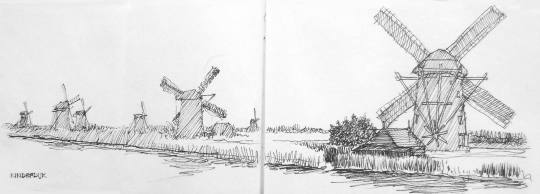
Below are some of my photos of the area: 1. the canal and a windmill with the modern turbine way in the background; 2. the living area on the interior of a model windmill; 3. the modern turbine pump that is used to move water from low to higher ground or back again.
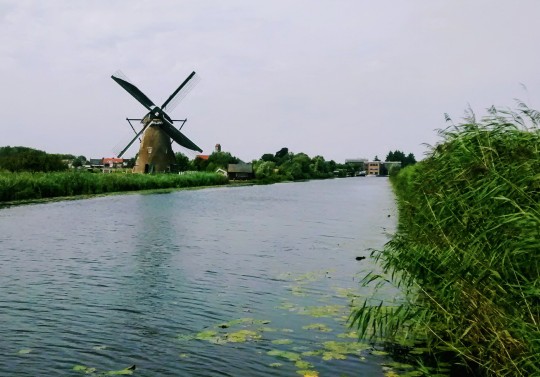


While the rest of the group went back to the ship at 4:30, some of us wanted to learn how cheese is made, and we went to a dairy farm where they make wheels and wheels of Gouda cheese (pronounced HOW duh). I’ve been through dairy farms in upstate New York and Hungary, and again here. The cows here were eating grass that smelled so sweet, it did not make my nose cringe from the smell of the barns…much.



But we were able to taste and buy different varieties of Gouda, from selection that included black truffle infused cheese, pesto, stinging nettle (which, when cooked, is apparently quite good for the health, as my Hungarian guides at Dobogoko told me when they said they make a tea of it). There were garlic cheeses, pepper, and all kinds that I can’t even recall. I bought pesto cheese as a gift, and I have to say that Dutch cheese makes American cheese taste like rubber, in my opinion.
We returned to the ship by 7 p..m and were met by the ship in Rotterdam. It had left Kinderdijk on its way to Amsterdam.
A really nice dinner of surf and turf (I was warned about the “surf” since I have a shellfish allergy, and they kindly made me just a filet mignon). I splurged by buying the Bordeaux special wine at 11 euro per glass, because you have to have a good red wine with a good piece of steak. The administrative staff—the Captain, Jadranka and Leonard, and the Maitre d’ Nenad, all toasted us and Leonard made a sweet video showing us all enjoying our time on the cruise. I would post it, but it primarily shows the people we cruised with having fun and not much about the places we saw.
Bittersweet to say good-bye to everyone and then go and pack everything up in the room. The next day, many would be leaving the ship by 4:00 a.m.
#Kinderdijk#windmills#turbine#goudacheese#dairy farming#calfs#rembrandt#myvikingstory#vikingrivercruise
0 notes
Photo

The Cologne Cathedral, a UNESCO World Heritage site, was begun in 1248 and completed in 1880--photo by Roy Williams
Grand European Tour, Budapest to Amsterdam – Day 13
August 22, Cologne (Köln), Germany
We arrived in Cologne just as breakfast was ending and headed out on a walking tour of the city by 9:15. I have to admit, the cobblestones were getting to me. So I took a really leisurely tour that was mostly walking around and sitting someplace to hear the guide tell us stories about different places in the city. The Cathedral was the primary focus, though we didn’t go in with her. Other passengers said they went in with their guide and took photos of an enormously high ceiling inside. What our guide did tell us was that in a refurbishment of the cathedral, lots of Roman ruins were found, which prompted the city to open a Roman museum right next to the cathedral. Several centuries-old sarcophagi were lined up outside the museum that had been found beneath the cathedral. The thought of someone having died about 1000 years before I was born put the idea of a “lifetime” into a new perspective for me.
The name of the city – Cologne – of course referred to scents, and there were two particular shops that sold them. The perfume had a citrus scent, not heavy like French perfume. More of an orange-lemon crispness. I liked it and regretted that I did not buy any for a gift or for myself.
The main thing I learned about the cathedral was that those in charge anticipated that a war would ruin the stained glass windows and some of the valuable things they had in the building. During both World Wars they took out the stained glass windows and put them in a safe place. Even now, most of the windows are not stained glass. During WWI, Cologne was a fortified city, and during WW II it was a key military area, and as a result, most of the city was bombed. The 11,000 Jews who had lived there had been either killed or deported and synagogues destroyed.
The other important fact was that the relics of the three Magi are in this cathedral. It is basically in honor of them, so it is a big deal at Christmas time. The Magi were astrologers from the east, and are honored here for having acknowledged Jesus’ importance and presenting him with gifts after his birth.
We returned to the ship for lunch and then there were optional excursions – one to UNESCO palaces in Brühl, and the other to to the roof of the cathedral with a guide. I chose the palace tour, and honestly expected to be bored – more palaces with frescoes and gardens and not being much different from the others. I was pleasantly surprised, especially since our guide gave great historical background to the places we visited.
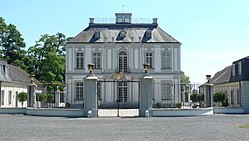
The first place we visited, Falkenlust, was built by a prince bishop who was the second or third son of a king. His older brother was, of course, in line for the throne, so the king gave this brother the title of prince bishop when he was 16. He did not like the idea of having to spend his life in celibacy, and his father said, “Don’t worry. Do what you want, just keep everything secret and be discrete.” So he created this “hunting lodge” that did not look like a hunting lodge, rather it was decorated in a way that was more appealing to the ladies. Blue and white diamond tiles (based on the Bavarian flag) with blue and white decorative tiles added in made up the foyer and stairway. Although he did bring friends in to hunt in the back woods, and there was a rooftop platform from which the ladies could watch the hunt (like a widow’s walk in New England). And the part of the name Falkenlust refers to the falcons that they used for hunting. a display on the grounds shows some of the falcon hoods and gloves. But the building was designed, in reality, as a Love Shack. The lower level had a garderobe—a changing room with a toilet, that opened into a lounge area for the lady, with a fireplace over which hung a portrait of the prince bishop in sleepwear (a la Hugh Hefner) drinking hot chocolate. That room opened into the lady’s bedroom, and across the salon part of the foyer was a dining room. The prince bishop had the same layout upstairs. There was no kitchen in the house. Ladies were very discretely taken there in the dark from the summer palace area one mile away.

The summer palace, Schloss Augustusburg, was a small palace (the real palace is now the University of Bonn) and this one was for summer vacations (tiles kept the dining areas cooler in the summer, and they were lower in the household), or it was a stopping point when traveling long distances to and from the palace.
The summer palace did look like a miniature Versailles and it had a large garden to the side of the palace.

Above: The University of Bonn, formerly The Electoral Palace (German: Kurfürstliches Schloss), the former residential palace of the Prince-Electors of Cologne.
We returned to the ship in time for a special briefing on what to do when disembarking in Amsterdam two days from today. It was a buzzkill. I, personally, did not want to leave the comfort of the ship after two weeks, and others had been on for three weeks (from Bucharest). So it is a jolt back to reality.
Another evening excursion was an exploration of Cologne’s Beer Culture—which included stopping at two pubs for beer and a German dinner in the city. Those of us who stayed behind were treated, after dinner, to classical music played by Cologne’s Academy of Music and Dance and WDR Symphony Orchestra.
#cologne#university of bonn#falkenlust#cologne cathedral#the magi#roman ruins#myvikingstory#vikingrivercruise
0 notes
Photo

Vineyards and a town along the Rhine River
Grand European Tour, Budapest to Amsterdam-Day 12
August 21, Middle Rhine River and Koblenz
The morning was sunny and a bit cool and breezy on the Rhine River, but we awoke to just the most gorgeous hillsides with a castle or medieval town at every turn. Leonard narrated a guided tour of what we were seeing around us, with a history of what happened in each castle or town. His information was very thoroughly researched and so interesting. This was the view I had dreamed of when choosing the route I wanted to travel—German castles on the Rhine. You even get a glimpse of it when you see the Viking commercial. But I have to say, in our technological and media-oriented world, it got a bit crazy with passengers sitting on the rooftop running from one side of the ship to the other just shooting photos on their tablets, phones and giant cameras. In my head I was singing Lady Gaga, “papa papa paparazzi.” I was tempted to do the same, but knew that I would not have enjoyed it half as much as if I just sat and looked and listened to Leonard. It was lovely and I decided to enjoy the journey, not so much the photo opps.
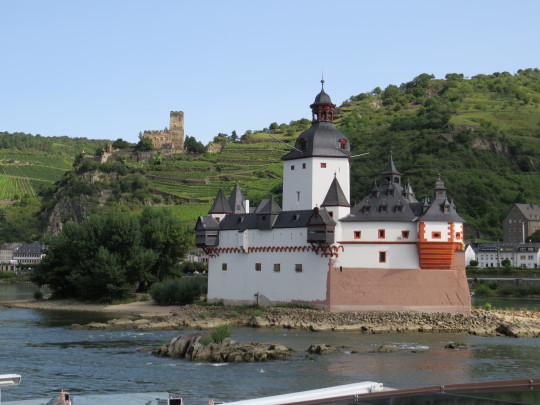

After lunch, the shore excursion to Marksburg Castle, a 700-year-old hilltop fortress, was the included tour, and I opted for a Moselle Wine Tasting instead which overlapped the Marksburg Castle. I did not obtain photos of that excursion from fellow passengers, but found this really nice YouTube video of photos taken in that castle.
https://youtu.be/-imJ2ukNxnw
Another optional excursion was to climb to the Ehrenbrietstein Fortress, which several people did, as well. There is a cable car ride [https://www.seilbahn-koblenz.de/homepage.html] that brings visitors up to it.

The Moselle Wine Tasting was, of course, enjoyable simply because of the chance to taste Rieslings from one of the best wine regions in Europe—from dry to Spätlese, made from late harvest grapes. The vines are planted on hillsides so steep, some are at 80 degree angles. Most have been planted horitzontally to make it easier to tend them safely, but now there are machines, apparently, that can trim and weed around the vines, but it is easier for them to go vertically up and down the hill. So some of the vine stock is being replanted to allow for that. But harvesting must be done by hand, and those steep inclines look treacherous.
We visited Winningen Winery where they said the Romans brought wine in originally because it was too complicated for them to transport wine from Rome. Some of the wine stock has been there since that time. They mixed wine with the water or honey, because the water was not safe to drink, and the alcohol made it safer. The Winningen Winery’s name includes Uhlen, or Owls, and they are on the steepest hills in Europe--a 60 degree slope. Originally they were grown on single sticks on the steep hills, but now they are doing more trellesses.
The common wine is Riesling and it is grown on south/southeast facing slopes to make about 40,000 bottles. They first check the taste of the grapes on October 1, and it takes 17 days to harvest, which they begin in mid-October. The grapes are crushed, fermented for six to 30 months. After bottling the wine keeps maturing and it should be consumed withint 7 years, Auslese around 20 years or more. The wine maker likes to drink the wine at 7-10 degrees Celsius.
Their wine was also labeled WEYH Weingut. I couldn’t figure out what the name was.
There is a big two-week long wine festival in the area.
We not only met with the owner and his son, we saw the 2-year-old grandson, who came in and sat at one of the tables babbling away. A Viking guest asked the boy’s father if he can speak English, and the father said, “He can’t even speak German.”
The owner told us that
I bought a bottle of the dry Riesling to share with the single ladies table.




While we were still on the Moselle Wine tour, the rest of the ship’s guests could attend a presentation on mysteries and truths behind the castles in the Rhineland and learn about the architecture of the region. I’m sorry to have missed that. The lectures on board have been great.

Dinner in the evening was not the usual selection from the menu, rather it was an Oktoberfest in August with the wait staff wearing outfits more like German traditional folk costumes, and there was a buffet of traditional German fare. For those not wanting to wait on line, there was a sampler platter, which I chose. However, everyone who waited on line got their meal before I did. The wait staff seemed a bit overwhelmed by the fact that everyone was there all at once waiting to have wine, beer, and other drinks plus special orders. There was bread at the table, but also pretzels. It was a very tasty dinner, but I have to admit I got kind of tired of pretzels. While we ate, we had a musical performance by a couple dressed in traditional garb brought in a wheeled instrument that looked like an old organ grinder contraption, but someone called it a hurdy gurdy. I looked up hurdy gurdy instruments and they were much smaller and could be carried.
The wine knocked me out and after dinner I went to bed, while the ship headed for Cologne in the middle of the night.
#koblenz#rhine river#castles#moselle#riesling#hurdy gurdy#organ grinder#pretzels#oktoberfest#cable cars#marksburg castle#ehrenbreitstein
0 notes
Photo

The 13th Century town of MItlenberg fit for a fairy tale
Grand European Tour, Budapest to Amsterdam—Day 11
August 20, Wertheim, Germany
Unfortunately, I do not have any photos of Wertheim. Why? Because I did an all-day tour to see how the nobles live in Germany now that they have to provide their own income. There have been no aristocrats officially since 1918. Here, though, they can keep their titles. The town they are in become part of their name and title.
The first place we visited, built in the 1500s, was the family of Furst (which is actually the word for“prince” related to the king—the prince bishop is prinz, and is an appointed position) Lowenstien Wertheim Rosenberg in the forest region known as Spessalt (a shortened version of the town name). Their family business includes forestry, furniture factories with pieces made from oak and beech. There is also glass production in this area since 1700, and the chandeliers from the palace residence were produced here.
Spessalt forest was ten times larger 200 years ago, with paths rather than paved routes. Because it was the forest, traders were robbed and the Brothers Grimm came from a place nearby to make a map of dialects. In order to do their study, they collected local stories and wrote them up, which we now know as Grimm’s Fairy Tales. Snow White came from a small town, and the dwarves in the story were small mine workers (there is iron which produces red soil, and the area is known for its red sandstone.
The property we saw first is owned by Gaven Marie Antoinette Echter-Ingleheim, and the area is a private park.

They breed trout in the surrounding ponds,
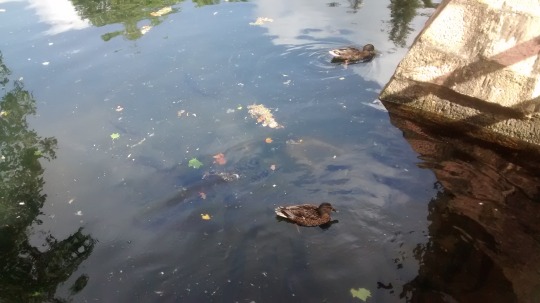
and we were treated to a taste of smoked trout with mild horseradish cream and their own sparkling wine, as well as some pate, which I thought was boar, but someone else said it was venison liver.
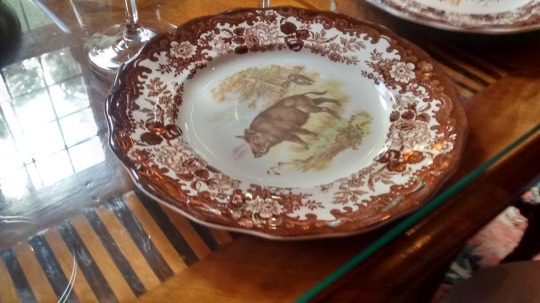
There is a knight’s hall in the palace with suits of armor and stained glass panels showing crests. The family has a hospital system and their wine cellar is the second largest in Germany—500 acres.


Marie Antoninette lives in Bonn in her husband’s castle, but comes back to run the family business. Her mother, the Duchess, lives here and stopped in to greet us. (no photos were allowed to be taken of her). On the property, the former mill is now a guest house and the horse stables are a restaurant. We all were invited to sign the guest book, and we were told that the Brothers Grimm had signed in as guests at the palace when they were in the area. Imagine that!
For lunch, we went to a quintessential German town on the Main river called Miltenberg that was built in the 1200s. A fortified castle stood high above the town with lots of steps to climb to get there. The streets were cobblestone from one end of the town to the other (it was literally one long street with smaller streets to the river).



We ate at the Riesen (the Giant) restaurant hotel, which was built I the 1100s, and is the second oldest restaurant in Germany. The food and wine was fantastic, but heavy for a hot August day. I imagine it would be very suitable for a cold January Sunday.

The shops that were open (most were not on Sunday), had cuckoo clocks and hand-crafted ornaments, of course.


The second aristocratic residence we visited was Schloss Kleinheubach, built in the 18th century by the architect who also built the Château de Versailles and was owned by Furst Alois Konstantin zu Löwenstein-Wertheim-Rosenberg. Half the building is now a conference center/hotel (only for large groups, not individuals), and the family lives in the other half of the house. Here is a video from the conference center website to get a sense of the property (it is in German with English subtitles).
youtube
On the family’s side of the house, there is a small private chapel where they attend services.
The horse stables were turned into a clean and bright winery, with mostly steel tanks – they produce Franconian wines such as Silvaner, and a red pinot noir. We were treated to a tasting of the wines they produce.

We returned to the ship around 5:00 p.m. and after such a long day I stayed in my stateroom listening to Leonard on the Lounge Cam talking about other Viking cruises available. I will post a summary at the end of the series of day-to-day blogs that summarizes other tours Viking offers, particularly from Budapest. But I will say that one he described—an around-the-world cruise that combines ocean vessels and river cruises and lasts about 140 days—sounds like an adventure I would like to do once in my life.
After dinner, and Leonard’s talk about what we will be doing tomorrow, he hosted a Night on Broadway quiz competition featuring favorite songs from famous musicals. I was so tired and just wanted to sleep, but Jadranka, the hotel manager, asked me to stay for the 10 p.m. disco party. She is a kindred spirit for me, so I had a drink with her – gin and tonic with cucumber—less sweet, more savory. I ended up dancing the night away, particularly some salsa with Leonard, the past champion dancer in Romania and judge for Romania’s Dancing with the Stars. He was impressed. Maybe not really, but he said he was by my dancing. And I ended the night dancing to Beyonce’s Single Ladies.
#aristrocracy#wineries#castles#trout#boar#forest#furniture#reisen#peeing boys#Mitlenberg#cuckoo clocks#wertheim#myvikingstory#vikingrivercruise
0 notes
Photo

High On A Hill Overlooking The Town of Würzburg, Germany , The Marianberg Fortress was built on the site of The First Church In Germany named after Mary, the mother of Jesus (Circa 706)
Grand European Tour – Day 10
August 19 – Würzburg, Germany
The ship stopped briefly this morning during breakfast in Markbreit/Ochsenfurt to let some passengers off for tours.
At 8:45 there were two tours—an optional one to Rothenburg ob der Tauber, a town along Germany’s “Romantic Road” well known for its well-preserved medieval history and look. It has hardly changed its appearance for centuries. The 1.5 mile wall surrounding Rothenburg connects five medieval gates which date from the 13th to 16th centuries. The entire area within the wall is a museum. This tour lasted from breakfast time until just before dinner.
The second morning tour was for shoppers, who took a shuttle bus to the Würzburg city center to shop. And then the boat left Markbreit and headed to Würzburg by lunch time.

In the afternoon, the excursion open to all was of the Würzburg Residenz to tour one of Germany’s largest and most ornate baroque palaces. This is the one I chose to do.

From the outside, the palace looked like the French Versaille, and in fact, a lot of palaces built at the time (between 1720 and 1744) were based on Versaille. The staircase inside featured an unsupported vaulted ceiling that had the largest ceiling fresco in the world—The Four Continents—which included an image of the architect and of other important people in the palace’s history, including the artist, himself. Unfortunately my camera died but here is a website with images of the frescoes at the palace.
The rooms were just opulent. A very ornate room or mirrors. A room of plaster rococo. Frescoes everywhere, and gold stucco and marble. In back there were expansive, impressive gardens. Very similar to Versailles, Schonbrunn Palace. And as we toured further along our journey, similar looking palaces popped up—making it difficult to remember which day and which place we saw which palace. Most were prince bishop residences—which makes you wonder why prince bishops needed such ornate and expansive places to live. The palace suffered significant damage in World War II, and was almost destroyed were it not for an American who had fallen in love with the beauty and artistic importance of the building, so that he mortgaged his own home to build a temporary roof that would save what remained and allow restoration to be done.
Here is a video about the palace showing some of the more impressive details:
youtube
We had a quick trip to the city, where we saw St. Killian church and Zum Stachel—which is described on its website as:
[T]he oldest guest house in the city, the restaurant and Weinhaus Stachel, [was part of Wurzburg’s turbulent history] too. Since 1413 there is a wine cellar, which was a popular meeting place for the city dwellers. In the 16th century, insurgents such as, for example, Florian Geyer, joined forces during the peasant wars. In conspiratorial gatherings, a morning star - the spike - was hung from the window as a sign. From this time comes the name, (Sting) which has survived to this day. The quaint restaurant, which gives the house a unique ambience, was designed by Heinz Schiestl in the early 1900s and remains unchanged today.
Below: 1. The various peaked roofs in the city center including the green-domed St.Mary’s Church; 2. Zum Stachel sign; 3. Zum Stachel spike hanging over the doorway; 4. Neumunster church,an 11th Century Romanesque Basilica built over the stone coffin of St Kilian ; 5. back of the Marienkapelle Catholic Church and the yellow Rococo style Falkenhaus, which is now a tourist office.





In the evening, after dinner, we had a live demonstration on board by a glassblower. I was exhausted so I watched it from the comfort of my bed on the Lounge Cam TV channel. A fellow blogger, Annie Coburn, who writes FabSeniorTravel, took these photos of the demo. Thanks, Annie!


On to Wertheim, and my Sunday spent at homes of the modern aristocracy.
0 notes
Photo
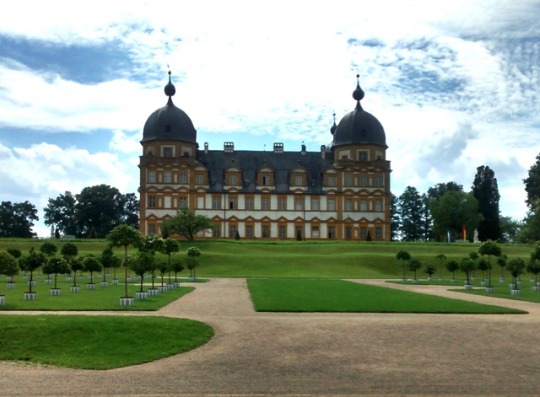
Seehof Palace and Park --the summer residence of the prince bishops of Bamberg
Grand European Tour-Day 9
August 18, Bamberg
The one thing to be aware of on a river cruise—locks, locks and more locks. There are about 67 locks between Budapest and Amsterdam, and sometimes at night you can feel the shift in smoothness from sailing to going through the locks.
Since we were not arriving in Bamberg until after lunch, we had a triva game today, and my friends Jo and Jack wanted me on their team. This was a general knowledge trivia game, and it was based on Leonard’s polling of past cruise guests and their answers to things like, “Name an instrument you can’t take on a plane.” The top answer was, “Piano.” Jo, Jack and I won, which we eventually found out later on. We got a bottle of sparkling wine.
At 1:30 most guests went on the Bamberg Walking Tour, which lasted until 6:00 p.m. Bamberg, sometimes called “the Franconian Rome,” because of its seven hills, each with a church on top, was a UNESCO World Heritage Site in 1993 based on its having the largest Old Town to retain its medieval structures. One of its more “modern” claims to fame is “smoke beer,” which dries green brewer’s malt over open fires (the ancient method), making it smoky. Nowadays, clean malt methods make smokebeers a rarity, and Bamberg has breweries that continue to use malt dried over open flames.
Instead of the Bamberg walking tour, I opted to do an excursion in the Franconian Countryside (former Kingdom of Franconia was merged into Bavaria, much to their disappointment). Our first stop was to a palace in the Franconian countryside that was the prince bishop’s residence (Prince bishops were not kings’ sons necessarily—”prince” in this case was a title as a ruler of a region who was also connected to the church). The residence was a huge yellow building topped with black-domed towers on each of the 4 corners, which overlooked a large, movable citrus garden (the plants went into the “orangerie” for the winter) and a lake out back. Statues surrounded the residence and once included fire, earth, water and air themes, but the boyfriend of the widow of a prince bishop, who moved in soon after the prince bishop was found dead in the lake, apparently sold everything he could, including the statues, in order to pay off huge gambling debts.
Below: The red and white entrance wall; the Seehof Palace


The weather was perfect and it was a lovely place to visit, with its big red and white entryway into the estate. One of my single-lady friends bought some Franconian wine here to share with a group of us single ladies at dinner. (Not everyone of us was single. Some were just traveling without spouses).
This very long excursion (which was happening while the boat was heading up river through locks), took us to a place in Memmelsdorf called The Three Crowns for pretzels and smoked beer. Sweet white wine mustard was served with the pretzels. We saw a large Maypole (in August, I know) being carried into the city with yellow and white ribbons (representing the Catholic Church). This was going to be a festival for the blessing of the church.

We left there and headed to a church in the Catholic Region known as the Maria Limbach Church—a simple Gothic design on the outside, with gold leaf Rococo interior on the inside thanks to a Prince Bishop who had heard of miracle cures there coming from the Virgin Mary. After being healed of a hip problem, he paid for the Rococo décor inside.

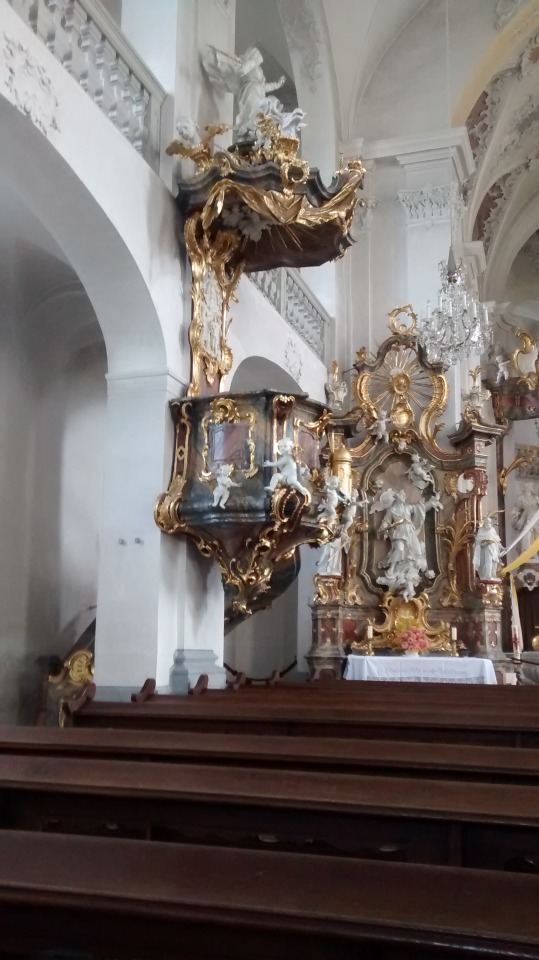

Last on the tour, we headed to Zeil am Main where the boat was going to meet us. Before going to the ship, we walked around the town to hear the tales of the witch hunts that took place from 1618-1630, and we saw the tower the so-called “witches” were taken to and tortured before being killed. It was very similar to Salem for similar reasons with a lot of the same tactics – the women were accused when they were different from other women in the town, then they were tortured in increasingly hideous and painful ways, until they confessed and also named five others in the town who were witches. (I recently substituted for a teacher whose lesson for the class was The Crucible this past spring, and these stories reminded me of that play).
The guide said he had been in the tower where the witches were imprisoned with 24 hours of light deprivation. He said the floor has been seen to light up and he, himself, heard laughter and moans when he was there.
Below: Church in Zeil am Main; The witches’ tower prison.


After a long and interesting excursion, I was beat, but after dinner, I went to the Lounge to hear a talk by the Captain on the ship and the waterways we were traveling on. I have discovered a way that if I am too tired to go to the Lounge, but I want to know what they are talking about, I can watch the Lounge Cam on my TV in my room (a good thing to be aware of when dancing or drinking or hanging out in the Lounge—others may be watching on their in-room televisions).
#Franconia#Bavaria#smoke beer#prince bishops r#Seehof palace#zeil am main#witch hunts#Limbach church
0 notes
Photo

The medieval town walls and tower in Nuremberg
Grand European Tour – Day 8
August 17 – Nuremberg
What do you think of when you hear Nuremberg? Nazis. And that is a big part of the tour in Nuremburg, but there are other lovely things to see and experience.
We were going through locks overnight and in the morning so we did not get to Nuremberg until lunch time. So our excursion took place after lunch, much of the time on the bus driving to see some of the Nazi-built structures like Kongressehalle, a coliseum-like structure that was never finished. It was supposed to have a roof and hold 50,000 people for Nazi rallies.
Below: Kongressehalle

We also saw the podium where Hitler stood in the Zeppelin field (Nazi Party Rally Grounds) where the rallies were held for up to 200,000 people.

We also drove past the building where the Nuremberg trials were held, which our guide stressed was the first time the nations of the world came together to put another country on trial for its war crimes. He said it was decided that it was a necessary step in making sure that something like this would never happen again. Below: the courthouse where the trials took place

An optional excursion focused specifically on Nuremberg and World War II. Those who chose this tour were able to get out of the bus to explore Zeppelin Field and the courtroom, and other historic sites related to World War II.
Another side of Nuremberg was its medieval wall, tower and castle and the remnants still standing from the middle ages.

In the center of town, you would never know that the city had such a dire past. The bright colors of fruits and vegetables under the red and white tents of the Hauptmarket, and the golden central fountain and Church of Our Lady Roman Catholic church overlooking the square. I bought some nice German chocolates nearby and several passengers stopped to buy gingerbread cookies. This is where the famous Nuremberg Christmas Market is held. In December, Viking has a cruise that stops along these same waterways to see the Christmas market towns, and Nuremberg is one of them. A toy museum is near the center and, of course, shops selling Christmas ornaments and crafts.


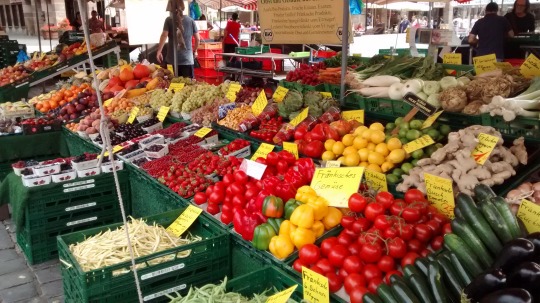
After we returned to the ship and had our dinner, Leonard had arranged for a live Klezmer Music performance on board—a kind of joyful music played at Ashkenazi Jewish celebrations . After that, the ship set sail for Bamberg.
#nuremberg#nazi trials#hitler podium#zeppelinfeld#Kongressehalle#hauptmarkt#chocolate#ginger bread#toy museum#fountain#church of our lady#klezmer music
0 notes
Photo

Grand European Tour – Day 7
August 16 – Regensburg, Germany
I was so excited for today’s tours, but it was a rainy, cool morning, and I was wary of the cobblestone streets in one of the best-preserved medieval cities that had survived WWII. It is the oldest city on the Danube and still has Roman gates standing since 179 A.D. So I opted for the easy walk.
Not far from where we were docked, there was a bridge that was the first completely stone bridge to be built—and was once considered to be one of the seven wonders of the world. Right next to the bridge was the oldest sausage house, which they believe was there to feed the workers who built the bridge in the 1100s. The sausage house is still in operation serving sausage
Below: 900-year-old sausage shack; first bridge ever completely made of stone.
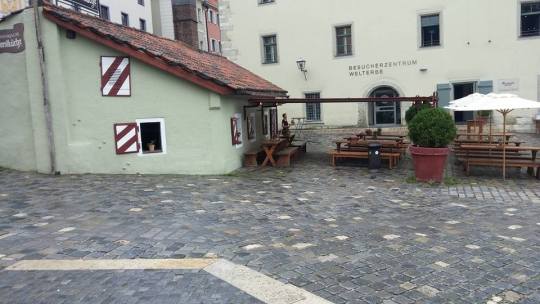

This town is sometimes referred to as the “Manhattan” of the middle ages because of the tall buildings that were constructed by merchants to show off their wealth. Bigger was better, and the faux Italian look was popular. However, the upper floors were empty (so they didn’t have to be heated), and the faux Italian aspect was just balcony bars and no actual balcony. Today the pink faux Italian building’s exterior is used as the residence of a popular TV show character in a German criminal series that is like CSI Regensburg, and the character of Mrs. Lucas lives in the pink tower Oscar Schindler lived her after WWII, and he is still remembered in the city.

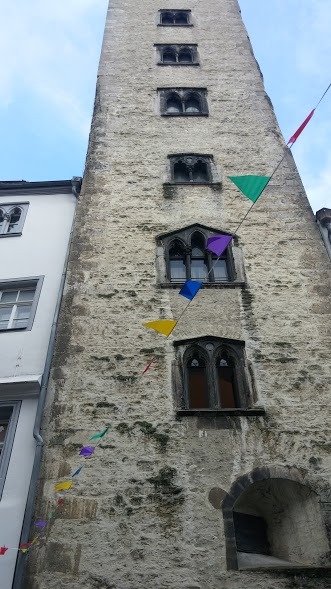
The Rathaus, or city hall, had a two old guys depicted in a frieze over the entrance. They are Mr. Schutz and Mr. Drutz—protection and defiance. Another sculpted figure along the street was the woman sticking out her tongue and showing her butt to her neighbors (sounds like the campers we saw along the river).
Below: Mr. Schutz and Mr. Drutz; Kiss My Butt stone lady


Walking around we saw lots of little shops – and I love German shops with their interesting little gift items and their Christmas ornaments. I didn’t even try to bring home a glass ornament, but went into a tin shop and got a couple. We passed this hat shop that has a photo inside of Johnny Depp, since they made his hat for Alice in Wonderland.
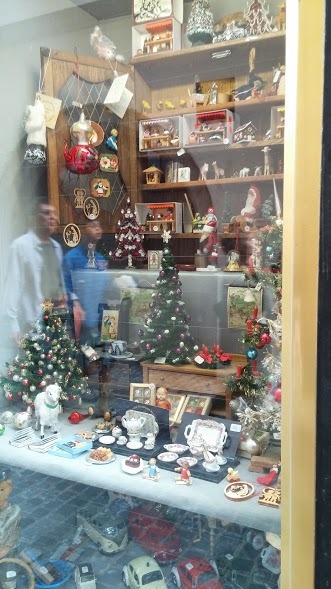

There were lots of bier gartens around the city, too, but that afternoon, as the sun came out and the air heated up, I was on a mission to make white sausage at the Ratskellar—the pub in the city that is beneath the Rathaus..

The owner is a master butcher and he has set up a huge room in the lower level of the restaurant to specifically teach people how to make this traditional homemade white sausage that you cannot buy, even at his restaurant, to eat, because of the laws for selling sausage along with the need to make enough in advance of each day’s business changes the flavor. So we had the benefit of mixing it all together, stuffing it, cooking and eating it with glasses of wheat beer and sweet mustard, which actually tasted pretty good with it all. I do not like sausage, generally, but this sausage was amazing. It was a combination of pork and veal, mixed with onion, lemon zest parsley, baking soda and spices and then we added fat and ICE, the key ingredient. The processor had a temperature gauge and it could not go higher than 15 Celsius. I really liked it. I ate four pieces!

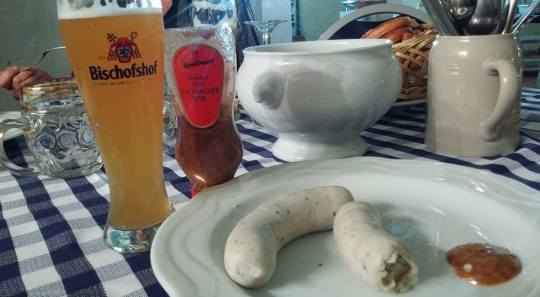
Other passengers went on a Jewish Walking Tour of Regensburg and some took a trip to Munich.
One thing I have to say about meals as a person traveling alone—it’s not always easy to find a seat. Most people traveled with partners or spouses, and some with family members. So the tables had an even number of seats and settings. But while on the beer and pretzel boat in Passau, I met two sisters traveling together and a single woman sitting with them. They had two other single women traveling together that would sit with them at their meals. So there was always one empty seat, and we eventually ate quite a few meals together (you are not assigned seating at meal time). We were on the basic drink plan, which normally means the same red and white wine every night at dinner – except for a couple of nights. So some of us would buy a bottle of good local wine while we were on a tour and bring it to the table to share with the others rather than pay extra money on board for a glass of the better wines, which were often priced per glass what we paid (or more) for the whole bottle.
#Regensburg#sausages#first stone bridge#Schutz and Drutz#kiss my butt#pink building#CSI Regensburg#ratskeller
0 notes
Photo

Photo courtesy FTP Edelman -- Passau, Germany
Grand European Tour – Day 6
August 15 - Passau
Woke up, opened the curtain and went outside onto the balcony and saw a camper van parked on the riverside with a bike and a table outside. As we went along, I noticed more people camping along the river—one man lying outside on a lounge chair in the cool morning air, and families with kids playing near the water. This began a trend—more and more campers along the riverside, some kayaking, some waving at us as we went by, and one group lined up, turned away from the ship and dropped their pants to moon us!
Passau is a town filled with cobblestone streets and archways that give it an Italian vibe. My group’s guide, Sebastien, was wearing lederhosen and making jokes about being Bavarian, independent and not liking foreigners (except tourists who spend their money). I said, “That sounds familiar.” For me, the cobblestone streets are a challenge with their uneven surfaces and the constant feeling of almost tripping. But locals and others in the group seem not to notice the bumpiness.

The shops in the town were closed today because of the Catholic Feast of the Assumption—and lots of European locations will close on Catholic holidays. We passed by the Cathedral that had lots of people inside, but we could not go in until the mass was finished to look at the interior artwork and statues.
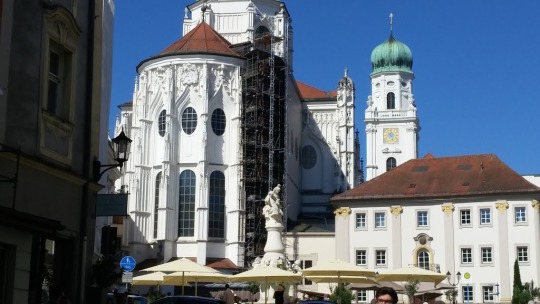


By that time, the whole town was full and we headed down a cobblestone hill to a Feast Day Festival, where Sebastien plied us with Lowenbrau beer. I gave my cup to the man behind me, since beer doesn’t appeal to me. I did buy a pretzel thinking that I wanted to get a good German/Austrian pretzel while I had the chance. Little did I know that throughout Germany I would have the opportunity for free pretzels at almost every stop we made. In fact, we went on the ship for lunch, and there were pretzels on board.
The afternoon excursion was a Bavarian Cruise and visit to a Baroque Town called Schärding. The cruise was in a nature preserve area on the Inn River in a wooden boat with tables and chairs. The drivers of the boat served pretzels and beer (or some other non-alcoholic drink) and told us some of the history of the area.

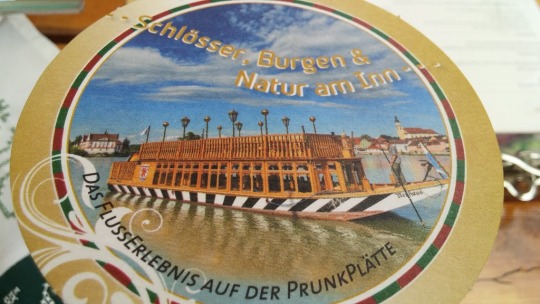

In fact, one story about the Good King Wenceslaus in the Christmas Carol made me think twice about how good he was. We saw a statue in the river of St. John of Nepomuk, who was supposedly tortured and thrown from a bridge by King Wenceslaus in Prague because John, who was Bishop, would not reveal to the King the information told to him by the Queen in her confession. St. John of Nepomuk is now patron saint of bridges and rivers as well as of fire brigades. There is a statue of him on the Inn River. The first, from 1013, was called St. John of Nepomuk “the reliable,” but when that statue was washed away, it was replaced and the name changed to “the unreliable.”



The tour disembarked the beer boat at a bridge that crossed the border between Passau in Germany and Schärding in Austria, where we saw the town’s colorful buildings and lots of cobblestones, again. As we were enjoying pretzels and drinks on the boat and wandering through the town, our cruise ship headed up river through several locks and we met them along the river at a brief stop on the way to Regensburg.
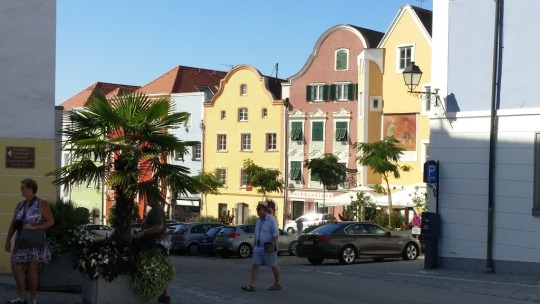
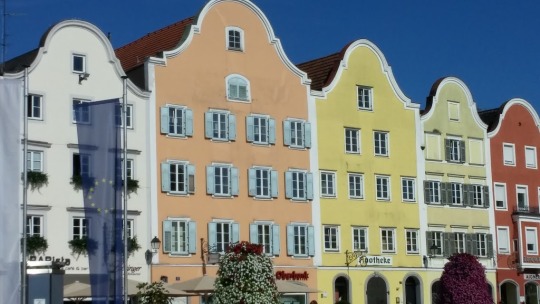
The walking tours just knocked me out. I tried to rest after dinner and watch a movie, but passed out happily, knowing I would do a full day of activities in the next port.
#scharding#passau#beer#pretzels#bavaria#lederhosen#cathedral#feast day#festival#austria#germany#medieval#wenceslaus#St.John of Napamuk#patron saint
0 notes
Photo

Melk Abbey in Austria, courtesy of my cruise friends Jack and Jo.
Grand European Tour --Day 5
August 14 - The Wachau Valley and Melk, Austria
I woke up this morning and peeked out window to see lovely towns and homes and churches along the riverside in the UNESCO 2000 World Heritage Site: Wachau Valley, the stretch on the Danube between Krems and Melk. This morning, up on the rooftop, our Program Director Leonard commented on the vineyards and towns and castle ruins as we all took photos to capture the beautiful landscape that drew many of us onto this particular cruise—old, picturesque European riverfront towns. UNESCO chose this area because: “The architecture, the human settlements, and the agricultural use of the land in the Wachau vividly illustrate a basically medieval landscape which has evolved organically and harmoniously over time.”
This was lovely and it got even more impressive further north on the trip, but here are a few shots of what I woke up to. I was so grateful to have a private balcony to go out onto and snap these photos with my phone (which abandoned me eventually).



By lunch time, we arrived at Melk Abbey, which was built about 300 years ago as the palace of Leopold II of Badenberg. It was given to the Benedictine monks in the 11th Century. Most impressive was the Abbey Church and its library which contain around 80,000 medieval manuscripts. We were told not to take photos inside the building, and the panoramic view was so impressive from the outer walls that you could not get one shot that was sufficient. But my friends from the Cruise provided me with some of their good shots—mine were trapped on my dying phone. These from my friends Jack and Jo on the tour.


The surprising thing about the Abbey was that many of the interior rooms were quite modern and set up like a museum. Most interesting to me was the library. There were secret doors to go through in the bookshelves, and the reading areas were behind the bookshelves where there were windows for light. The guide told us about the different topics studied at the monastery through the centuries (it still has more than 700 students attending). One thing they taught was astronomy, but I noticed astrology images and references and when I asked her afterward, she said that astronomy and astrology were taught together as one subject until about the 1800s. Interesting it was taught in a monastery.
Since we were not permitted to take photos of the interior, this photo of the library is a stock photo from Austrian photographer is by Paul Troger.

By 3:30 we were all back on the ship and it soon departed for our next port, Passau. But we were treated to Austrian teatime with pastries and coffee or tea. But that night, after dinner, one of the most enjoyable and meaningful presentations was given about The Sound of Music…With a Twist, by Leonard, who says he watches the film about twice a year.
0 notes
Photo

Vienna--the entrance to the Lippizaner Riding School
Grand European Tour--Day 4
August 13 - Vienna
Early to rise today with a 9:00 a.m. tour of Panoramic Vienna. Was up early enough for a full breakfast, and went of the ship to tour Vienna. Having been there a few times, I have seen much of what we saw. The panoramic tour did not include inside tours of the palaces or buildings, other than walking through the foyer at the Lippizaner Riding School.
(Below: 1. Hapsburg Wineter Palace, 2. Inner dome of the LIpizzaner Riding School)


A later excursion would take some guests behind the scenes at the Lippizans. When I brought a group of Ag Business students to Hungary and Vienna, we stopped there, and it is really just a walk through the stables to see some of the horses. You get to see the showroom, where the horses perform, but it is empty.
Optional tours also included a full day immersion into Viennese traditions—including coffeehouses and Sacher tortes--and another excursion to Schönbrunn Palace, the Hapsburgs’ summer home outside the city, for a tour.
While they were touring, I was exploring the rooftop deck, and found these herb gardens growing fresh lavender, rosemary, parsley and other herbs.

I also enjoyed a more casual lunch in the Aquavit Terrace. Hamburgers—which became one of the favorite lunches when offered (it varied—hamburgers, hot dogs and brats, chicken wings, fajitas, and usually sandwiches and soups with a small salad selection). Fruit was always on the menu as well as all kinds of breads and pastries. And all day, outside the lounge, were two coffee stations with cookies available all day. The triple chocolate were my favorite, which the chef told me were put out at dinner time, so I would grab a couple and wrap them in a napkin and bring them back to my room for a midnight snack if I were watching a movie.

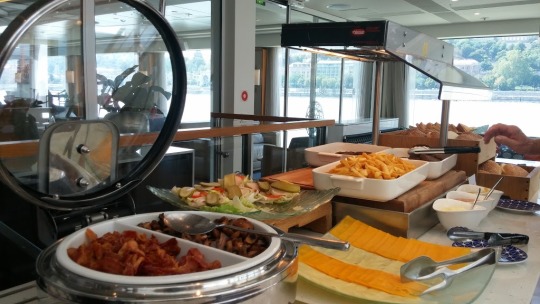

When everyone was back on board, our Program Director Leonard had arranged for an entertaining historian to speak before dinner, during the cocktail hour about Austrian history from medieval times to now. It is interesting that they do talks and things to motivate guests to come to the Lounge during the cocktail hour. From 6:45 to 7:00 p.m. every night, Leonard would brief us in a very entertaining way on the next day’s tours, and give us details of times and locations. As soon as he was finished, dinner was served. After dinner, Emil would play the piano for the music and dancing part of the evening.
At midnight, we left Vienna as I sat on my balcony chatting on my phone with Google Hangout to talk to the U.S.--one of the last good connections I had to do that. My phone was dying and the internet outside of a big city like Vienna was not strong. This is a view from the rooftop deck in the daytime and from my balcony as we left Vienna at night.
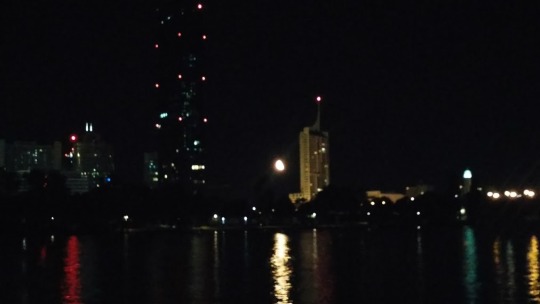

We were headed to Melk Abbey, an impressive bright golden yellow building on the hillside overlooking the Danube. I was excited. Years earlier—in 2000—on my first trip to Europe, I had gone on a business trip to Salzburg for a Salzburg Seminar in the Schloss Leopoldskron where Sound of Music was filmed outside. After the seminar, I wanted to go to Vienna, and thought of taking a short cruise from Salzburg that would stop at Melk Abbey. It all seemed so enchanting—traveling on the river and visiting an Abbey that was almost 300 years old at the time. On this cruise, I would have my chance to experience it all and to take in the amazing views from above the Danube.|
#myvikingstory#vikingrivercruise#vienna#schonbrunn palace#hapsburg winter palace#lippizaner riding school#herb garden#hamburgers#salad bar#salzburg
0 notes
Photo

Heroes’ Square in Budapest
Grand European Tour Days 2 and 3
August 11-- Budapest Tours and Setting Sail on the Danube
For me, the second day on the ship in Budapest was more about the food and less about the tour, since I have gotten to know Hungary pretty well. Even though there was an excursion to the Hungarian Puszta region to see the horsemen outside of the city, I have seen them already. So as I have been preparing my own meals most of this summer and making fairly simple foods, the idea of having a big, tasty breakfast was very appealing. Pancakes, eggs, bacon, tea, and fruit. A breakfast bar offered fresh made omelets and fried eggs. Poached could be ordered with the waiters. Dishes of scrambled eggs, bacon, sausage, fruits, and a hot cereal area featuring oatmeal and other hot cereals. There were Norwegian and European breakfasts, as well, along with breads, pastries, and dry cereal.
(Below: breakfast in the dining room: 1. yogurt selection, 2. Bacon, eggs, tea, and croissants, 3. Pancakes and fruit with butter and syrup, 4. waffles on the buffet, 5. Breads and pastries, 6. European breakfast selection of meats and cheeses with brioche.


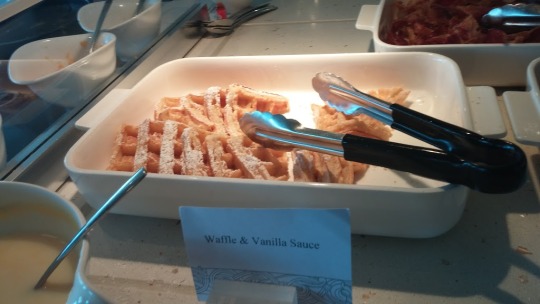


I explored the ship and interviewed Jadranka Brajkovic, the Hotel Manager to find out more about what they do to keep 190 people per tour happy and coming back for more. One thing she said was that they want the crew to be friendly and happy, and that you can’t really do this job long if it is not something that makes you happy yourself. Viking, she said, does a lot to try to make working conditions for crew members good, including days off during the tour. They also are offering a variety of options to some of the now younger retirees and working people taking river cruises. They have more activities and hands-on options, as well as more involved excursions for those who are interested in those. Guests who want to just relax and have an easier time have options for leisurely tours with less hurry and more chances to sit or ride if walking is more challenging.
The other guests had the option to visit highlights of Buda and Pest, including the Opera House, Heroe’s Square, and on Castle Hill Fisherman’s Bastion and Matthias church. There were optional tours to see the horsemen, the Grand Market (Vasarcsarnok, which I explored in the food tour with Taste Hungary), and the Synagogue and Jewish Budapest. I saw some of that with a Taste Hungary sightseeing tour, which I will post more about after the Viking River Cruise posts, but here are some photos showing the synagogue and the shoe memorial. (Several cities on the cruise offered tours specifically exploring the Jewish experience as well as the Nazi presence, as we’ll see in Nuremberg).
(Below: 1. the Dohany Street Synagogue, 2. The shoe memorial--bronze-cast replicas of actual shoes left on the side of the Danube in mid-winter when Jewish residents were brought there in the middle of the night, told to take off their shoes and were then shot and allowed to fall into the water and die).


Dinner was delicious. I took photos of my meal and my new friends’ meals (Jackie and Al, transplants from Long Island to South Carolina), and while we were dining and being toasted by the Captain and Hotel Manager, our boat headed out of Budapest toward Vienna.
(Below: 1. filet mignon dinner with steak frites, 2. salmon appetizer, 3. Scallop dinner, 4. watermelon and arugula salad with breaded goat cheese croutons.)


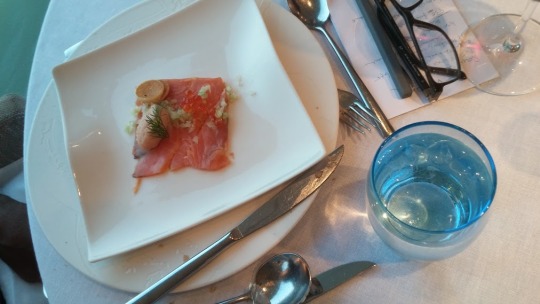

Sailing away from Budapest to Vienna (below):

August 12 Sailing on the Danube and Arriving in Vienna
Arrival in Vienna was not until the evening, so our energetic and entertaining Program Director, Leonard MIron (who was an anchor on a Romanian morning show, as well as a judge on the Romanian “Dancing with the Stars”) came up with some other ways to keep us busy. One was a tour of the wheelhouse to see the Captain’s dashboard for sailing the ship—lots of GPS monitors and a joystick for steering. Radar allows him to sail at night and in the fog. The chef did a demonstration of strudel making and Leonard talked about Vienna coffeehouses and Mozart as a prelude to an optional excursion after dinner to see a symphonic concert featuring the music of Mozart and Strauss. I had not signed up but at the last minute decided to check it out and go. Many times it is possible to sign up for an optional excursion though they are also possible to sign up for online months in advance of the cruise.
The concert was at the Weiner Koncerthaus. A small symphonic orchestra played, and singers and dancers performed. Several other Viking Cruise ship guests were in the audience, from other boats heading up the Danube or down to Budapest.
When we returned to the ship, a special midnight meal of Goulash (gulyas) soup was served on the outdoor terrace.
#budapest#myvikingstory#vikingrivercruise#breakfast#dinner#budapest synagogue#shoe memorial#budapest castle#vienna#weiner koncerthaus
0 notes
Photo

A Viking long boat parked near the Chain Bridge in Budapest.
The Grand European Tour from Budapest to Amsterdam on Viking River Cruises
Day 1--August 10
It was brutally hot as I headed to the piers from the outer districts of Budapest to a place I was told was near the Elizabeth Bridge to board my home for the next 14 days--a Viking River Cruise through Austria, Germany and the Netherlands to Amsterdam. Unfortunately, the information I received was not the right pier and by the time I realized I needed to go to the Chain Bridge for my ship (too far to walk), I was drenched from head to toe. So much for looking like a professional freelance writer.
But things turned around 180 degrees once I boarded the ship. I missed a wine and cheese tasting, but was happy to get to my room and see the day’s agenda, and take a quick shower to be ready for a 5:30 cocktail hour and a brief introduction of what to expect for the next 14 days as we sail from Budapest, to Austria, Germany and the Netherlands, ending up in Amsterdam on August 24th. Here is what I found when I got to my room:
youtube
Those things that look like remotes that I did not know what they were...they are called Quiet Voxes and they are worn around your neck with a single earphone connected to them. Every time you go on a tour, you are assigned to a group with a number (our ship was 31) and a letter (A through whatever the last group is). The guide has a “lollipop” paddle with the number of your group and you touch the Quiet Vox to the paddle and it turns on your connection to the guide’s microphone. This way the guide does not have to shout. You don’t have to try to stay close to the guide to hear what is being said, and everything is pretty clear. Most guides carry extra Voxes with them in case the one you have did not charge or is not working.
Our Viking Daily newsletter showed the weather and gave an outline of the day’s destinations and a bit of background on places we were visiting with suggestions for what to do in each city--including where to go, where to shop and where to eat.
At dinner, we could sit with whomever we wanted to. Since I did not know anyone else, and most people were traveling as a couple or even as a group, I sat at the first table I saw, by the entrance door. The waiter, Joseph, got to know me quickly so that by the next morning he knew me by name and knew some of my preferences (for tea), and eventually just knew what to expect. I also had a food restriction -- no shellfish--and the Maitre d’, Nenad from Serbia, introduced himself to me and explained the menus, and gave me a small card with my number on it to show that I had a food allergy to alert any waiter to be careful about what they serve me. But Nenad went over the entire day’s menus every morning with me at breakfast to guide me in my food choices.
After dinner, we were treated to a special surprise--a scenic sailing in the Danube to view the magnificent illuminated Budapest Parliament, Castle, and bridges--a treat not always available because there are often activities going on in the Danube that do not allow it. Though I am familiar with Budapest and have seen these buildings many times, including on short boat rides or from Spoon, a floating restaurant, at night, it’s something you never tire of--and Jadranka Brajkovic from Croatia, the Hotel Manager, said she has viewed this brief sailing many times and never got tired of it. Most of us went up to the rooftop deck to see the sights and it was magical.



I slept well that first night, in a Queen-sized bed all to myself (my video said King--I got carried away) with A/C on 72 degrees F. I knew I could sleep in (a bit--breakfast ends at 9:30 a.m.), because I was not going on the Budapest city tour. I have been to most of the places they went to. I was scheduled to interview the Hotel Manager while the other guests were touring.
#Grand European Tour#myvikingstory#vikingrivercruise#Budapest#stateroom tour#Danube River#budapest at night
0 notes
Photo



A Walk in the Park -Margaret Island (Margit Sziget)
It seems trite to say that Margit Sziget, or Margaret Island, is the Central Park of Budapest, but literally, it is centrally located in the Danube River between Buda and Pest. It was at one time a hunting ground for the rich and known as the Island of Rabbits in the 13th Century. Before that, it was the summer home of a Roman commander from Aquincum, the area of Budapest once occupied by the Romans. The island only became usable by the public about 100 years ago. Now, the island offers a reprieve from the busy-ness of the city, a variety of ways to decompress. From numerous spas and swimming facilities, to natural walkways and open green spaces, tennis courts, sports complex as well as an open-air theater, statues, rose, rock and Japanese gardens with a thermal spring running through it that fills the area with steam in winter, the island is even reminiscent of Saratoga Springs. In addition to the above, there is a petting zoo and a “singing fountain” –a very popular source of relaxation and entertainment with both classical and popular music synced with water sprays that are programmed to match the music.
Extra benches and new landscaping makes the fountain more accessible to more people, who sit or dance or relax nearby. At night, colorful lights are added to the mix of synchronized fountains and musical entertainment.I was looking for a walk in nature and a drink at a café with a pastry or small bite to eat. I took the Hev to Margit Bridge from Batthyany Ter, because of events that caused the Buda-side tram to be not running. The 4 and 6 trams run across the bridge and stop in the middle at the entrance ramp from the Bridge to the Island. I walked past the swimming pool being set up for the FINA World Aquatic Championship competition there.
I stopped to take a photo of the beautiful Centennial sculpture and flower garden, which I found out was commissioned in 1973 to celebrate the 100th anniversary of the merging of Buda and Pest into one city.
youtube
Just past that sculpture the musical fountain was calling to me with the Dire Straits song, “Money for Nothing” I wasn’t the only one getting into the music, and I did a short video of some girls moving to the music (see earlier post on this blog), and saw some young boys lip syncing to a later song.I moved on in search of a café that I knew I had enjoyed a few years ago, but was disappointed to see that it was under heavy construction for a remodel.
I saw a sign on a fence that said something about Hippie Island, and when I looked to my right and saw the 1960s swirl of colors, I thought it was some kind of amusement park, because it had that carnivalesque look to it—kind of like a bumper car ride, or something similar. So I went a bit further and sat on a bench to decide what I wanted to do and to watch the people going by. A lot of pedal-powered vehicles went by, and some motorized rides, as well as scooters, and skateboarders. A group of kids started a game with a ball in the open grass in front of me, and lots of people walked by with towels and swimming stuff on the way to and from the Uszoda (swimming pool). Hunger got the best of me and instead of continuing to walk further along into the Island, toward or past the beautiful octagonal Art Nouveau water tower built in 1911, I headed back toward the ramp to the bridge. The Water Tower is something I enjoy seeing, but I decided to pass this time—and when I get back there, will add a photo here.
Hippie Island



Walking back to the Margaret Bridge, I took a look toward Hippie Island, and saw that people were sitting inside. The construction work being done on the other café made me think nothing else would be open in that area, but I headed over there to check it out. I’m glad I did. It was a big open deck with shady trees and canopies and lots of tables going all the way to the edge of the river overlooking the Pest side, north of the Parliament. A glass wall separated the restaurant from the outer walkway and cushioned jogging path but it was a lovely view of passing boats and people walking by. The wine list was short, but had really nice quality brands and varietals, and the foods were really interesting. I chose a guacamole platter with a small salad and some toasted bread (isn’t avocado on toast a thing in the U.S.?) Another great aspect was the rock and roll music playing that I actually enjoyed listening to. I’m not normally one who likes music with my dining unless it is ambient “dinner” music. The side wall was filled with photos of 1970s musicians, and a lot of shots of the traffic heading to Woodstock. To see upstate NY (my home state) in a restaurant, with music playing from your own teenage years, and food and wine that you love, makes any less-than-perfect service (which there was) less frustrating. The problem was that the table area was so large and the number of servers was limited, and a large family arrived that needed extra servers, so getting simple things like a napkin and fork, as well as refills of my wine and water took longer than I liked. But Hippie Island is a place I would definitely go to again, and I would take into account the service challenges.
I went home happily full of guacamole and wine and a head full of memorable tunes. Soon I will try to get to the rest of the island for a few more photos.
#margitsziget#margaret island#musical fountain#hippie island#guacamole#good wine#danube river#japanese gardens#swimming pools#art nouveau#water tower#cafes
0 notes
Video
youtube
A view from above on a $10 ride on the Budapest Eye
0 notes